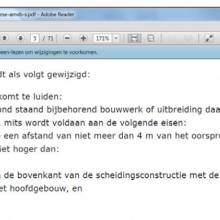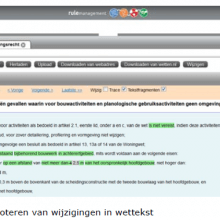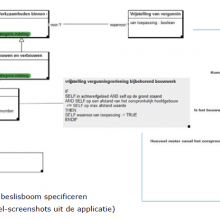Regelbeheer is een cruciale factor in de bedrijfsvoering van veel organisaties. De wijze waarop dit is georganiseerd bepaalt het succes van de informatie voorziening van zo’n organisatie. IAM4 hanteert als basisprincipe voor het inrichten van regelbeheer “De bollenplaat” ©
Elke bol representeert een deel van het proces van beleid tot uitvoering, dat zijn eigen dynamiek kent. Een bol bestaat uit een cyclus die herhaalbaar uitgevoerd kan worden. Op raakvlakken van de bollen vindt overdracht plaats van eindproducten uit de voorgaande cyclus naar de achterliggende cyclus en bevindingen hierop vice versa.
In de cyclus van beleidsontwikkeling wordt de wet- en regelgeving gemaakt. Iedere organisatie heeft zijn eigen proces, met eventuele variaties, voor beleidsontwikkeling. Zo zijn er binnen de rijksoverheid 8 hoofdstappen waarin een wet tot stand komt. Het begint met de voorbereiding van het wetsvoorstel op het ministerie. Het wetsvoorstel wordt besproken in de ministerraad. De Raad van State komt met advies. Het voorstel wordt daarna behandeld in de Tweede Kamer en hier wordt gestemd. Vervolgens wordt over het voorstel gestemd in de Eerste Kamer. Tot slot ondertekenen de Koning en de minister het voorstel en treedt de wet in werking na publicatie. Voor een AMvB en ministeriële regelingen wordt een aantal van deze stappen overgeslagen.
In de cyclus van interpretatie wordt de wet- en regelgeving omgezet naar een eenduidige implementatie-onafhankelijke functionele beschrijving. Om tot een eenduidige interpretatie van wet- en regelgeving te komen dient een nauwgezette analyse plaats te vinden, waarbij alle ‘onvolkomenheden’ die in de wet- en regelgeving besloten liggen in overleg door juridische experts opgelost worden. Het betreft zaken als vaagheden in begrippen, ontbrekende definities, onvolledigheden, tegenstrijdigheden en soms zelfs cirkelredeneringen. De eenduidige interpretatie wordt vastgelegd in een model.
Alle elementen van het model zijn verbonden met de juridische bron waar ze uit zijn afgeleid. Dit betekent dat de impact van wijzigingen in de wet- en regelgeving en bijbehorende documenten, zoals jurisprudentie, direct inzichtelijk zijn. Uiteraard dienen deze wijzigingen zelf weer geïnterpreteerd en in de modellen verwerkt te worden. Er ontstaat zo een nieuwe versie van het model.
Vóór de interpretatie en modellering van de regelgeving dienen de beoogde gebruiksdoelen bepaald te zijn. Zeer gedetailleerde analyse en modellering heeft immers alleen zin als het gebruiksdoel dit ook vereist. Het beste voorbeeld hiervan is een quick scan op nieuwe regelgeving. Het doel is een eerste, globale analyse van de regelgeving, waarmee uitvoerbaarheidsaspecten teruggekoppeld kunnen worden naar de opsteller van de regelgeving. Pas als de regelgeving daadwerkelijk in uitvoering genomen moet worden, is een diepgaande analyse en modellering noodzakelijk.
De modellen kunnen in diverse representaties worden vastgelegd, zodat deze door verschillende medewerkers gebruikt kunnen worden. Dit varieert van een tekstuele beschrijving van de beleidslogica tot een formele vastlegging die direct te automatiseren is.
In de cyclus van ontwerp worden de producten en diensten gespecificeerd. Voor verschillende producten en diensten zijn er verschillende ontwerpprocessen. Zo zijn er bijvoorbeeld voor communicatieproducten grafisch ontwerp processen en voor applicaties systeemontwikkelingsmethodes. In al deze ontwerpprocessen zal ergens de vraag gesteld worden waarvoor het product of de dienst bedoeld is. Deze functionaliteit, inclusief bijbehorende gegevens, worden in belangrijke mate bepaald door de regels (zoals wettelijke eisen, productbeleid, bedrijfsbeleid) die gelden. Op dit punt wordt gebruik gemaakt van de resultaten uit de interpretatie.
In de cyclus van implementatie worden de producten daadwerkelijk gemaakt op basis van de specificaties uit het ontwerp. En vervolgens worden deze producten in de dienstverlening van de betreffende organisatie in gebruik genomen. In de uitvoering kan de dienstverlening vervolgens stuiten op allerlei problemen. Deze problemen kunnen signalen vormen voor het starten van de ontwikkeling van nieuw beleid.
Voor elke organisatie kan dit proces worden toegepast en ingevuld met eigen kenmerken.





